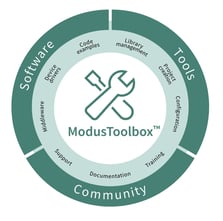Qt for MCUs 2.10 Out Now!
March 31, 2025 by Meron G. | Comments
Qt Group is pleased to announce Qt for MCUs 2.10, a release packed with exciting new features designed to broaden GUI capabilities across IoT, consumer, and automotive segments. This update is filled with enhancements that will empower developers to create even more dynamic and efficient applications.
This blog lists some of the standout highlights from the 2.10 release.
Qt Location: Maps on MCUs
In our ongoing effort to optimize microcontroller use cases, we are excited to announce a new feature: loading map tiles on a Qt Quick Ultralite UI. This implementation retrieves map tiles directly from the MCU's local storage and utilizes pre-rasterized map tiles to minimize storage and download requirements. This approach significantly reduces current consumption by eliminating the need to mirror map tiles from a phone. By leveraging the GPU, it ensures efficient map rendering on MCUs, delivering top performance with minimal memory usage and maximizing hardware capabilities.
Potential applications:
-
Two-Wheelers: Enhance navigation systems in motorcycles and scooters with efficient, low-power map rendering.
-
Wearable Devices: Integrate maps into smartwatches and fitness trackers for on-the-go navigation.
-
IoT Devices: Enable location-based services in smart home devices and industrial IoT applications.
-
Drones: Improve navigation and mapping capabilities in drones with real-time map rendering.
-
Outdoor Equipment: Equip handheld GPS devices and other outdoor gear with detailed, responsive maps.
The Qt Location API now supports STM32U5G9 MCU on BareMetal, with the flexibility to be easily adapted for a wide range of other MCUs.
Qt will continue to improve this feature by integrating navigation capabilities.
Dynamic animations with StateGroup
StateGroup in Qt Quick Ultralite manages and animates UI component states, creating smooth, dynamic animations in response to user interactions or events. It allows one to define and manage multiple UI states, create seamless animations, and trigger state changes based on interactions. Optimized for microcontrollers, it ensures smooth animations with minimal resource use. The benefits include simplified state management, enhanced user experience with smooth transitions, dynamic responses to interactions, minimized memory usage, and high-quality animations leveraging the GPU.
StateGroup in Qt for MCUs 2.10 is a powerful tool for creating dynamic, engaging UIs on microcontrollers. Explore its capabilities to elevate your embedded applications.

Infineon ModusToolBox IDE integration
Qt for MCU 2.10 has enhanced QUL package compatibility with the MTB IDE, enabling developers to configure and optimize QML projects using graphics drivers tailored to the target hardware with QUL support. This integration simplifies the development process by providing a centralized environment for configuration and optimization, ensuring that QML projects are fully optimized for the target hardware's capabilities.
The technical improvements include enhanced graphics driver support for optimized rendering performance and visual quality, dynamic resource allocation for efficient execution, advanced configuration options for precise graphics settings, and improved debugging tools for robust applications.
These enhancements make the development process more efficient and effective, leading to higher-quality applications with less effort. More features targeted at MTB IDE will be released in v2.10.1.
And more!
With the new support for lineHeight and lineHeightMode properties in QUL, developers can now achieve advanced text control, ensuring QML UIs match original designs imported via Qt Bridge from tools like Photoshop and Figma. This enhancement eliminates discrepancies in text appearance for MCU projects, making it easier to maintain design consistency.
The latest updates include improved resource initialization and checksum verification, efficient layer and VRAM usage guides for Traveo T2G boards, improved support for AUTOSAR targets, Safe Renderer Bitmap decoder, expanded pinyin dictionary, and simplified Qt Quick Ultralite library building for Zephyr.
Support for platforms has now been extended to MCUs like the PSoC™ Edge E84 on a Tier 3 level, and the ESP32-S3-BOX-3 will be upgraded to Tier 2 in release v2.10.1.
Specialized Squish support has now been extended to Qt Quick Ultralite applications operating on NXP boards.
The full set of new features can be found here.
What's Next
The next feature release of 2025 will be Qt for MCUs 2.11 in June. The main highlights will be:
- Extend Zephyr adaptation: As a Silver member of the Zephyr Project, Qt will broaden Zephyr OS adaptation to support more platforms
- Qt Navigation: Qt Location's Navigation feature will enhance map rendering and navigation for entry-level vehicle clusters and smartwatches, including positioning, route drawing, and map tilting. Initial data will be simulated, with plans for Bluetooth-enabled real-time data transmission.
-
Enhancing Translation Data Management with Configurable Memory Locations: Reserving translation data in external flash allows independent updates, reducing production, maintenance, and testing costs.
- Letter spacing support.
- Squish support for ESP32 boards
Several new features will be introduced throughout the year. It is advisable to check for updates regularly. A comprehensive list of changes in this version can be found in the changelog.
Deploy Qt for MCUs 2.10 now for optimized embedded applications
If you already use Qt for MCUs, you can download version 2.10 from the Qt Maintenance Tool in your installation folder. If you're new, click here to start. The new features and improvements are designed to add value to resource constrained embedded systems. Please share feedback and requests in the comments!
Blog Topics:
Comments
Subscribe to our newsletter
Subscribe Newsletter
Try Qt 6.8 Now!
Download the latest release here: www.qt.io/download.
Qt 6.8 release focuses on technology trends like spatial computing & XR, complex data visualization in 2D & 3D, and ARM-based development for desktop.
We're Hiring
Check out all our open positions here and follow us on Instagram to see what it's like to be #QtPeople.





Extra Casino J’aime beaucoup la https://extra.casinoconnexionfr.com/ des jeux disponibles et la simplicité de l’interface. Les bonus sont généreux et permettent d’augmenter son temps de jeu. C’est un casino qui mérite d’être testé.